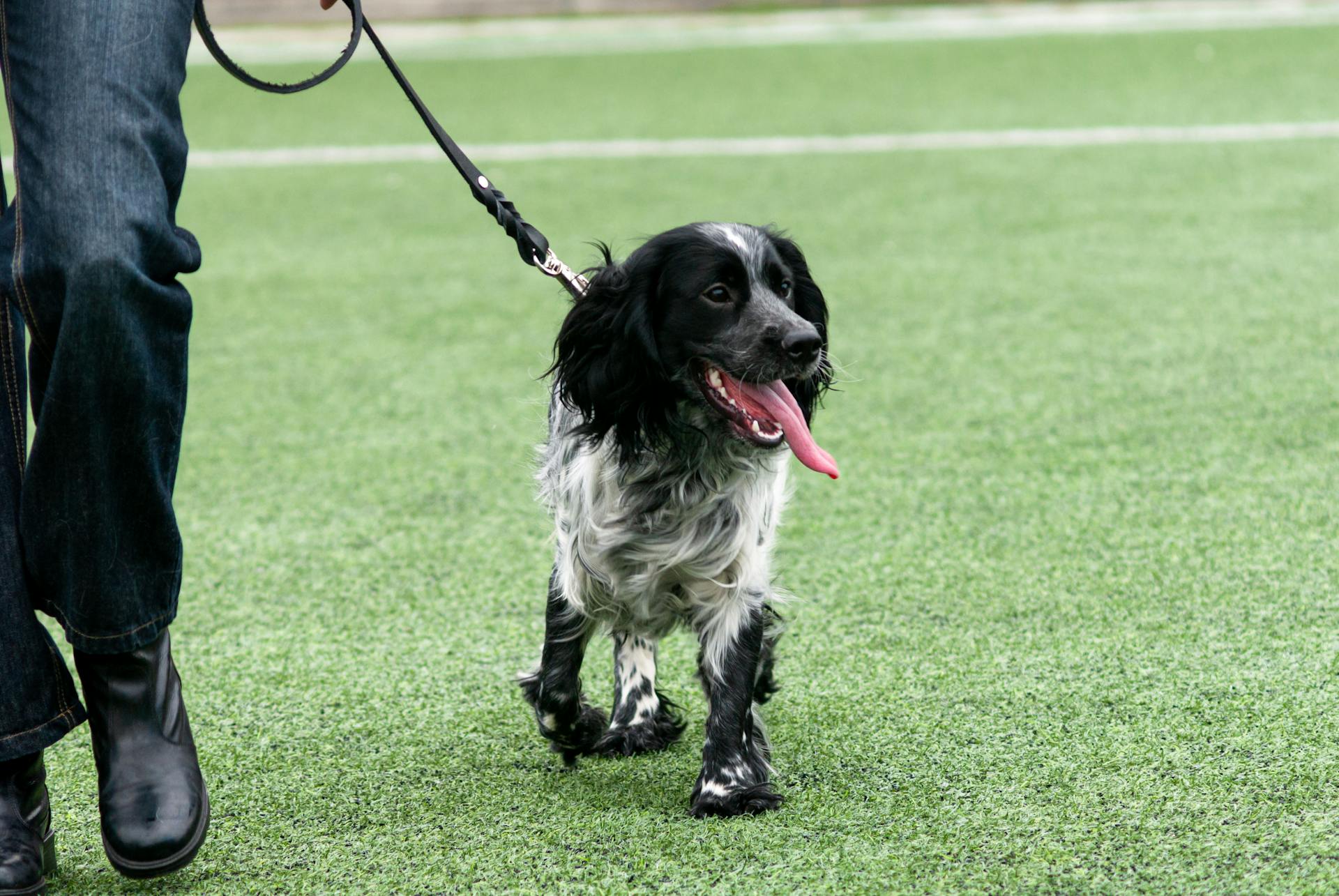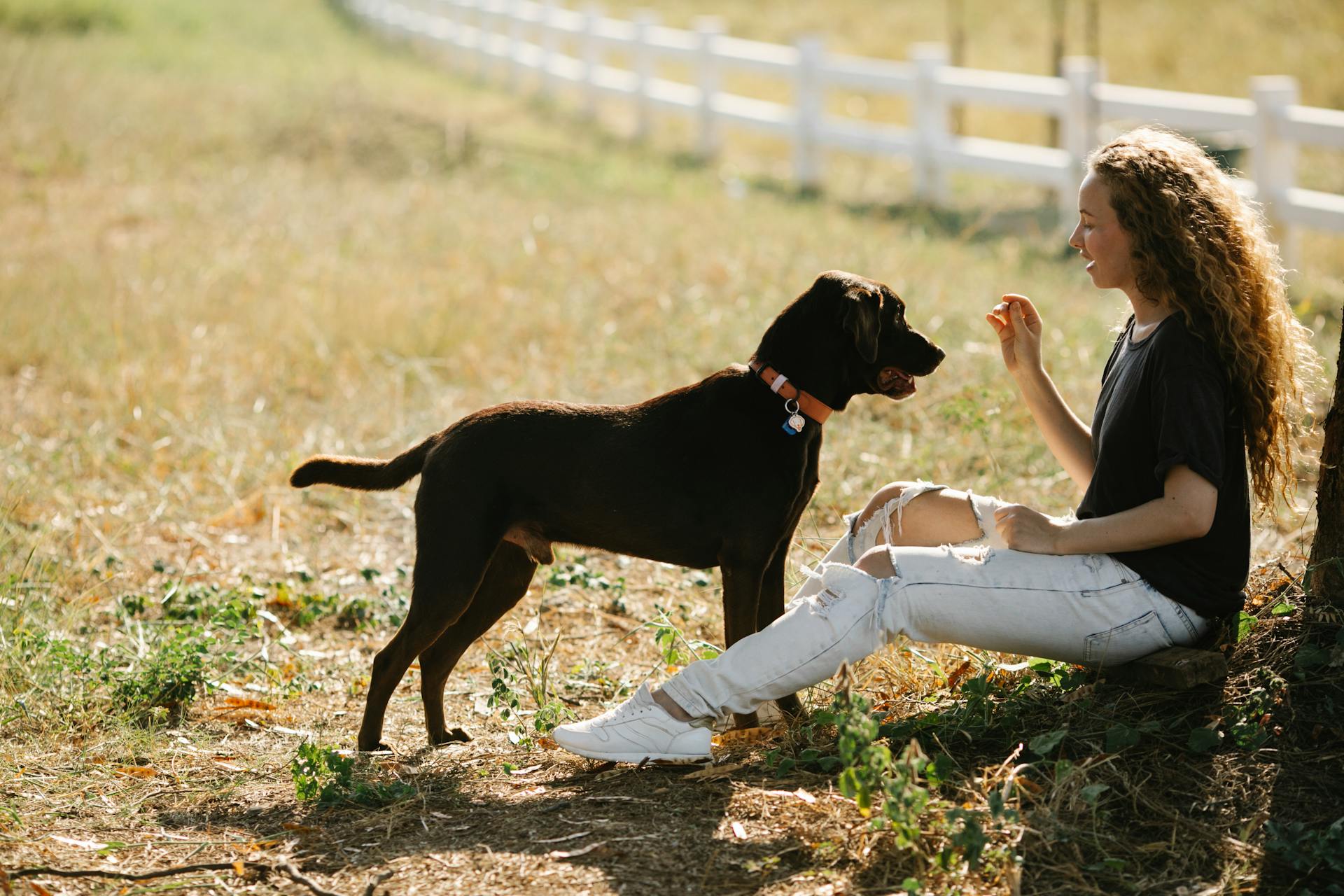
A martingale collar and a slip lead are two popular training tools used to help manage a dog's behavior. The key difference between the two lies in their design and functionality.
A martingale collar is designed to tighten when the dog pulls on the leash, whereas a slip lead is a simple, single-piece design that can cause discomfort to the dog if not used correctly.
Both collars have their own set of benefits and drawbacks. A martingale collar is ideal for dogs with long necks or those that are prone to pulling on the leash.
A slip lead, on the other hand, can be more suitable for smaller breeds or puppies that need gentle guidance.
For another approach, see: Dog Training Lead Leash
What Is a Collar?
A collar is a simple piece of equipment, but it's essential for dog owners to know what to look for.
There are different types of collars, but for this discussion, we'll focus on the martingale collar style.
Martingale collars have two loops, a smaller one with a D-ring and an adjustable larger loop that hangs around a dog's neck.
This design causes the collar to constrict when the leash is pulled, preventing the dog from slipping out.
The martingale collar is also known as a no-slip or limited-slip collar, which means it's designed to keep the dog safe.
Unlike slip leads or choke collars, martingale collars won't tighten beyond the dog's neck width when fitted properly.
This is a crucial safety feature that sets martingale collars apart from other types of collars.
Suggestion: Ban Shock Collars
Benefits and Uses
Martingale collars are a great alternative to traditional collars, especially for dog owners who have issues with their dogs slipping out of collars. They work by tightening around the dog's neck when they start to pull, but release when the dog stops pulling, preventing choking or harm.
For dog breeds with narrow heads, such as Greyhounds and Whippets, martingale collars are a must-have to prevent slipping out of their collars. This is because these breeds can easily slip out of a traditional collar.
You might like: Shock Collar Definition

Martingale collars are also commonly used by dog trainers for leash training, as the slight tightening of the collar can inform the dog to stop unwanted behavior. This is a more humane approach than using choke chains or prong collars.
To ensure a martingale collar fits right, it's essential to get a proper fit, which will provide safety from escapes as well as safety from the collar getting too tight during a pull.
Broaden your view: Is Shock Collar Cruel
Safety and Precautions
Martingale collars are safe to use when used properly, but certain dog types should not use them. Small dogs with fragile necks, puppies, and dogs with bull necks or tracheal collapse issues should avoid martingale collars.
Dogs with neck or breathing issues, or those with eye problems like Glaucoma, should also steer clear of martingale collars to avoid putting additional pressure on their necks and eyes.
Martingale collars are not meant for everyday wear, but rather as a training and escape prevention tool. They should only be used under complete supervision.
Any collar, including martingale collars, carries a small risk of choking if caught on something. However, martingale collars have some slack, which increases this risk.
Studies have shown that dogs respond better to positive training methods than aversive training methods.
Consider reading: Small Bark Collar
Choosing and Fitting
Choosing and Fitting a Martingale Collar is crucial for a comfortable and effective fit. You'll need to measure your dog's neck and head to get the right size.
Measure the circumference of your dog's neck and head using a soft tape measure, making sure it's not too tight or loose. If your dog's neck is larger than their head, use the neck measurement, and vice versa.
For standard martingale collars, add 1-2 inches to the larger measurement, depending on your dog's size. This will give you the correct size range, such as 16-18 inches for a larger dog.
Take a look at this: How to Measure for a Prong Collar
How to Size Life's Collar?
To size Life's Collar, you'll want to measure your dog's head and neck. Measure the circumference of your dog's head at its largest point, usually behind the eyes but in front of the ears.
You'll also need to measure the smallest part of your dog's neck, just behind the ears. Measure multiple spots in that area to ensure you get the smallest neck measurement.
Discover more: Walk and Train Head Halter
Next, measure the largest area of your dog's neck, where a collar would naturally sit. This is usually where you'll find the largest measurement.
Add 2 inches to the largest of these three measurements to determine the correct Life's Collar size. This is the method used by Best Life's Martingale Collar sizing chart.
It's essential to choose the correct size and width of the collar, as the widths can vary depending on the color of the collar. Be sure to review the sizing information on the product page to ensure you select the right size and width for your dog.
Additional reading: Martingale Collar Size Chart
Adjusting for the Perfect Fit
To get the perfect fit for your dog's martingale collar, start by loosening the collar all the way with the sliding adjuster. Moving the slide towards the stripes makes it smaller, while moving it away from the stripes makes it larger.
Measure your dog's neck and head to ensure you're choosing the right size. Measure the circumference of both areas with a soft tape measure, and don't measure too tight or too loose.
Worth a look: How to Measure for Martingale Collar

If your dog's neck is larger than their head, use the neck measurement. If their head is larger, use the head measurement. For standard martingale collars, add 1 inch extra for small dogs and 2 inches extra for medium or larger dogs to the larger measurement.
A correctly fitted martingale collar should be just a tad loose when not pulled. The two metal sides of the D-Ring should always be at least one inch apart.
When pulled, the two sides should never be able to touch. To achieve this, adjust the collar so that you can slip two fingers between your dog and the collar, and then pull the D-ring lightly to ensure the collar tightens properly.
Always check that the limited-tighten feature prevents the collar from tightening beyond the width of your dog's neck, but still can't be slipped off.
See what others are reading: What Is a Dog E Collar
Care and Maintenance
If you've been using a martingale collar for a few weeks and your dog keeps pulling through it, keeping it constantly tight, it's time to try a different approach.
Consider consulting a trainer who may recommend a different tool, as suggested in the article.
The Go-Dog-Glo Harness uses pressure around the body rather than around the throat, making it a potential alternative to a martingale collar.
Don't forget to regularly inspect your martingale collar for signs of wear and tear, as this can affect its effectiveness and your dog's comfort.
Alternatives and Options
If you're not sold on martingale collars or slip leads, there are other options to consider.
One alternative to both martingale collars and slip leads is a harness. Harnesses are a great option for dogs who pull heavily, as they distribute the force of the pull across the chest and shoulders.
A head halter is another option that can be effective for dogs who pull on the leash. By fitting the halter around the dog's muzzle and nose, you can steer the dog in the desired direction.
Choke collars are often considered a last resort, but they can be effective in certain situations. However, they can be uncomfortable for dogs and even cause injury if not used properly.
Some dog owners have success with clicker training to teach their dogs to walk on a loose leash. This method focuses on rewarding good behavior rather than correcting bad behavior.
Suggestion: How Do I Stop My Dog Pulling on the Lead
Frequently Asked Questions
Do vets recommend slip leads?
No, vets generally do not recommend slip leads as a safe or necessary option for dog owners. A standard leash and collar is considered a safer choice for walking your dog.
What is the controversy with slip leashes?
Slip leashes are criticized for causing an unpleasant feeling when a dog pulls, leading to unwanted behavior. This issue arises during walking training, where the leash tightens around the dog's neck.
What is the best collar for a dog that pulls?
For dogs that pull on lead, a martingale (or training) collar is a great option, available in various colours and designs from online pet stores. Consider the Black Dog Wear "training collars" as a reliable choice for effective and comfortable use.
Sources
- https://www.oscarandhooch.com/blog/what-is-a-martingale-collar-and-uses-for-them/
- https://www.stuntpuppy.com/products/martingale-limited-slip-collar
- https://bestlifeleashes.org/blogs/news/the-best-life-martingale-collar-what-why-how
- https://myfirstshiba.com/martingale-collar/
- https://blog.theartfulcanine.com/martingale-dog-collars/
Featured Images: pexels.com


